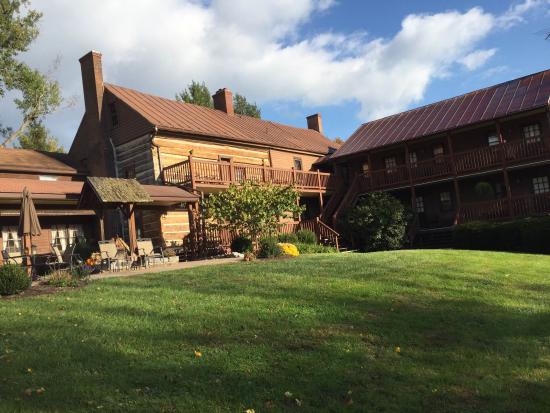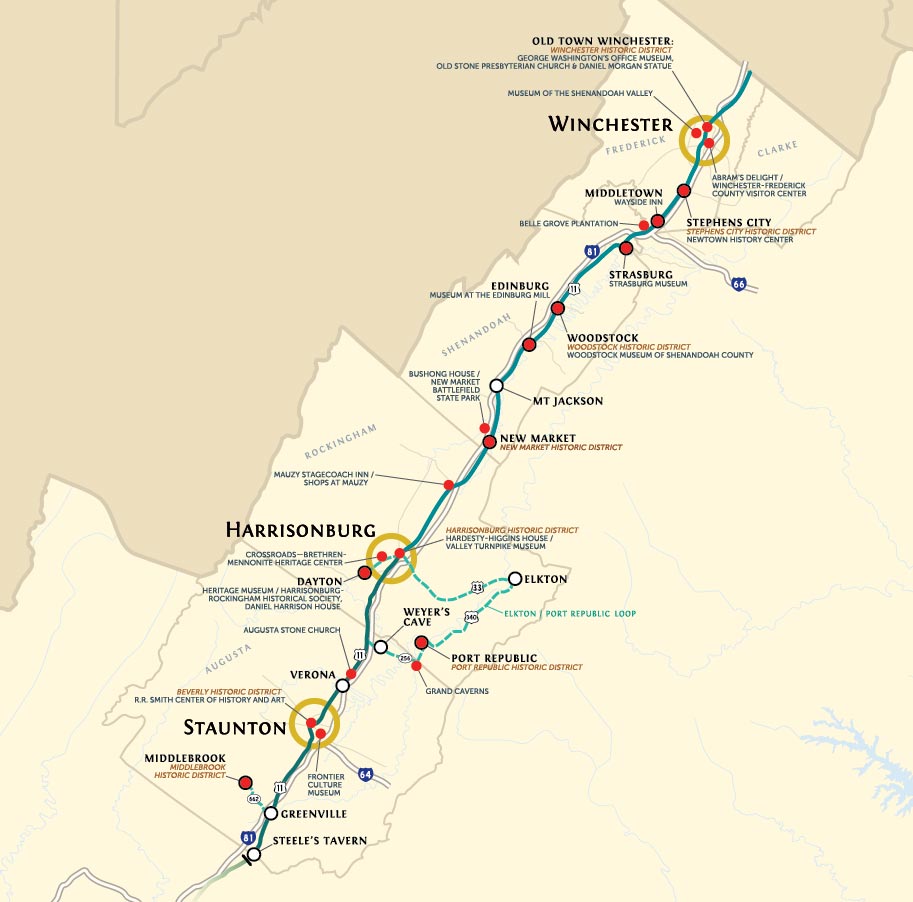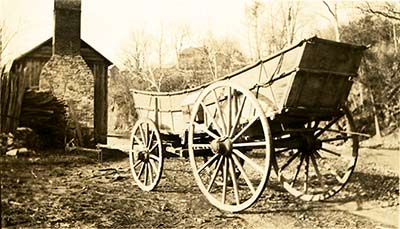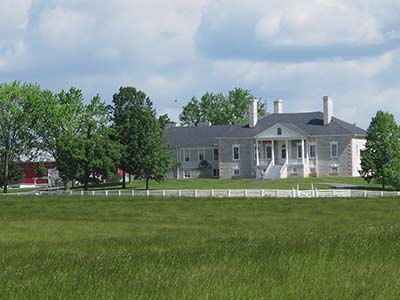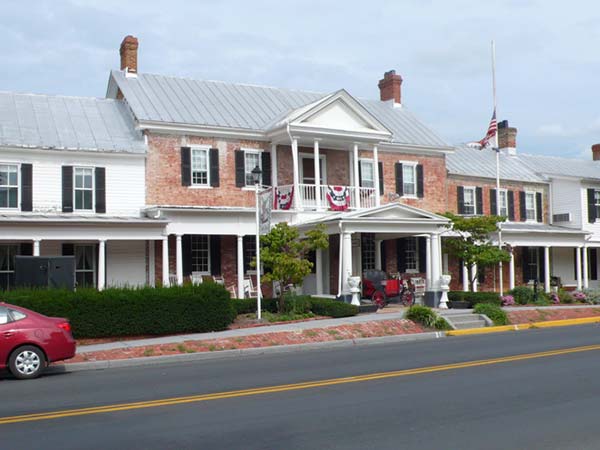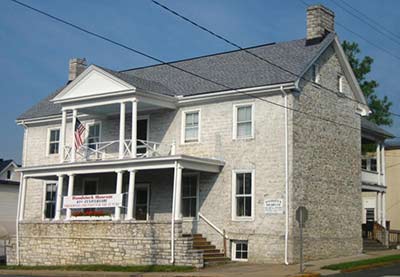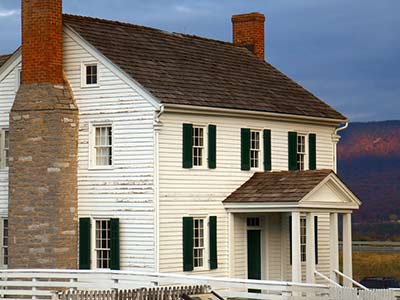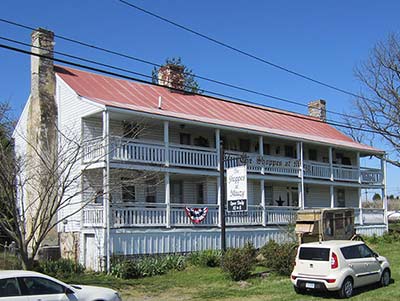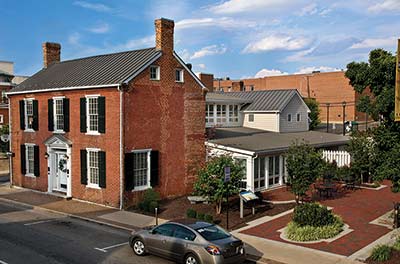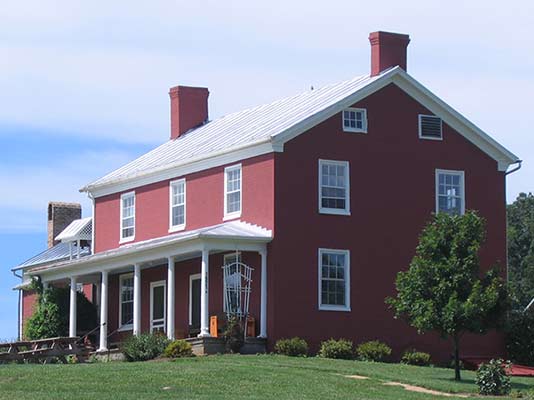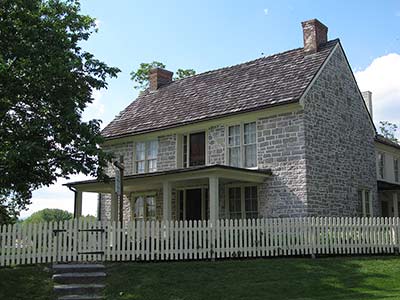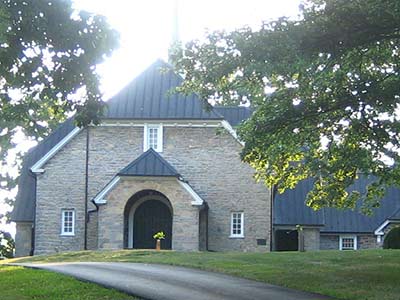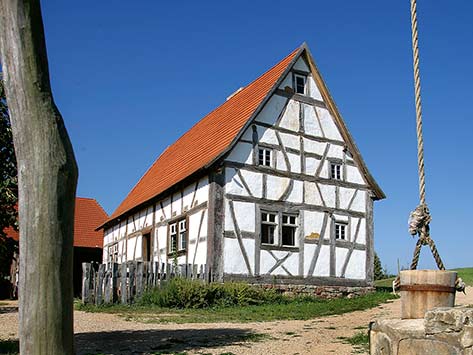Sites
The Inn at Narrow Passage
30 Chapman Landing Road Edinburg, Virginia 22824
Website
Driving Directions
The ‘narrow passage’ on the Great Wagon Road through the Shenandoah Valley of Virginia (now U.S. Route 11) was a popular spot for Indian attacks. Settlers often took refuge behind the inn’s sturdy log walls over the next 20 years. Located on five private acres along the Shenandoah River in Woodstock, Virginia, our Inn offers 12 guestrooms, a well-equipped conference room for small executive meetings, many common areas, and lovely grounds to host retreats, family gatherings, and relaxation not far from Northern Virginia.
George Washington’s Office Museum
Winchester Historic District, 32 West Cork Street, Winchester, Virginia
Website
Driving Directions
The unusual log and stone building known as Washington’s Office, one of Winchester’s oldest buildings, serves as a powerful symbol of Winchester’s connections with the French and Indian War. Strong local traditions affirm that the earliest section of the house was used as a survey office by George Washington between 1749 and 1752, and that he returned to use it as a headquarters during the building of nearby Fort Loudoun in 1756–7. The museum interprets the ten years that Washington spent in Winchester.
Museum of the Shenandoah Valley
901 Amherst Street, Winchester, Virginia
Website
Driving Directions
The story of this regional history museum complex begins with surveyor James Wood’s claiming of the site in 1735 and his founding of Winchester in 1744. Anchored by the Museum of the Shenandoah Valley which tells the story of art, history, and culture of the great Valley for which it is named, the site also features the Glen Burnie House, dating to 1794, and six acres of gardens established in the last half of the twentieth century by Wood descendant and Museum benefactor Julian Wood Glass Jr.
Abram’s Delight Winchester-Frederick County Visitor Center
1340 South Pleasant Valley Road, Winchester, Virginia
Website
Driving Directions
The Visitor Center for the Winchester-Frederick County area is located adjacent to historic Abram’s Delight, Winchester’s most important site documenting the early period of migration and settlement. Abraham Hollingsworth (1685–1748), a prominent Quaker, was likely in the area by 1729. The large and elegantly appointed house was completed in 1754 for his son, Isaac, as is documented by a date stone in the gable.
Newtown History Center
Stephens city historic district, 5408 Main Street, Stephens City, Virginia
Website
Driving Directions
Stephens City, laid out in 1758, is the second oldest town in the Shenandoah Valley (after Winchester) and one of the best preserved of the “Valley Pike towns.” The Newtown wagon, manufactured at Stephens City, became legendary for its sturdiness among both Virginia farmers and settlers migrating to the far West, including the Gold Rush of 1849. The Newtown History Center, housed in the town’s earliest brick structure, interprets the history of the Great Road/Valley Pike and local manufacturing.
Belle Grove Plantation
336 Belle Grove Road, Middletown, Virginia
Website
Driving Directions
Belle Grove is the Lower Valley’s most architecturally distinguished building. The house was built in 1797 by a descendant of the area’s most prominent family of German origin. Builder Isaac Hite, Jr. (1758–1836) was a veteran of the American Revolution and the grandson of immigrant Jost Hite, partner in distribution of a vast land grant in the northern section of the Valley. The large, one-story limestone house is fronted by a temple-form porch supported by slender columns. The interior incorporates very fine Federal-style woodwork. The house museum includes an interpretive program and a gift shop.
Wayside Inn
7783 Main Street, Middletown, Virginia
Website
Driving Directions
Historic Middletown is located near the southern boundary of Frederick County along the Great Road/Valley Pike. The sixty-nine-acre town was established as Middletown in 1794. The Wayside Inn, also known as Larrick’s Hotel and Wilkinson’s Tavern, has operated there since it opened as a stagecoach stop in 1797. It continues to provide great food and lodging to travelers along the Great Road.
Museum at the Edinburg Mill Edinburg visitor center
214 S. Main Street, Edinburg, Virginia
Website
Driving Directions
The Edinburg Mill, a three-story frame grist mill, stands on the banks of Stony Creek in the well-preserved turnpike town of Edinburg. Built about 1850, Edinburg is one of the best-preserved antebellum towns in the Shenandoah Valley. The mill is one of a series of grain, wool carding, and saw mills that were built after 1813 by Philip Grandstaff and his son George. Today it serves as a museum of the history of Edinburg, the Valley Pike, and the milling industry. It houses a visitor center and gift shop.
Woodstock Museum of Shenandoah County
104 S. Muhlenberg Street, Woodstock, Virginia
Website
Driving Directions
Shenandoah County was settled predominately by families of German stock. Woodstock was established in 1761 and was locally known as Muellerstadt. The Woodstock Museum is housed in the two-story, stone Marshall House, which served as the home of President James Madison’s father Thomas from 1772–1781. It contains a fine collection of local and regional artifacts, including tall case clocks by local craftsmen Jacob Fry and Caleb Davis. The nearby restored Courthouse Square is home to the 1775 stone Shenandoah County Courthouse, with its German Baroque-style cupola.
Strasburg Museum
440 E. King Street, Strasburg, Virginia
Website
Driving Directions
Strasburg, originally called Staufferstadt, was settled in the 1730s by mostly German-speaking families. It was the home for 150 years of a thriving pottery industry and was often referred to as Pot Town. Housed in a two-story brick factory built for a local pottery manufacturer in the late nineteenth century, the Strasburg Museum exhibits historical tools, furniture, Native American artifacts, and local pottery.
Bushong House/New Market Battlefield State Park
8895 George R Collins Parkway, New Market, Virginia
Website
Driving Directions
New Market is a typical “turnpike town,” incorporated in 1796 at a major crossroad on the Great Road. Jacob and Sarah Bushong built the symmetrical frame house about 1825. In 1864, three generations of their family found shelter in the basement during the historic Battle of New Market as it was fought around the house. The New Market Battlefield State Park does an excellent job of presenting the lives and context of Valley residents, particularly those of Germanic descent, in addition to the site’s Civil War context.
Mauzy Stagecoach Inn/Shops at Mauzy
Intersection of Rt 11 & I81, north of Harrisonburg, Virginia
Website
Driving Directions
This antebellum stagecoach inn was built to serve travelers on the Valley Pike, 10 miles north of Harrisonburg. The long frame building is fronted by a two-story porch and includes a number of original outbuildings. Today it is open to the public as a collection of shops, selling gifts, decorative items and antiques.
Hardesty-Higgins House/Valley Turnpike Museum
212 South Main Street, Harrisonburg, Virginia
Website
Driving Directions
The land of Thomas and Sarah Harrison was selected in 1779 as the site for the seat of the new county of Rockingham. The town was provided with a central courthouse square, used as a model for towns across the nineteenth-century Midwest. The Hardesty-Higgins House, located directly on the route of the Great Wagon Road/Valley Turnpike, was begun by physician Henry Higgins in 1848. In addition to the Valley Turnpike Museum, which chronicles transportation through the Valley, it contains a visitor center, gift shop, and cafe.
Crossroads-Brethren-Mennonite Heritage Center
1921 Heritage Center Way, Harrisonburg, Virginia
Website
Driving Directions
Mennonites and Brethren have lived quietly in the Valley of Virginia for over two centuries. The Crossroads Heritage Center interprets their long history of faith, their unique farming traditions, their pacifism, and their legacy of craftsmanship to tourists and members of the Brethren and Mennonite communities. It incorporates an outdoor museum, including the relocated 1854 Burkholder-Myers House, home of an important Mennonite bishop, and the Whitmer School/Cove Mennonite Church, a one-room school house/meetinghouse.
Heritage Museum/Harrisonburg-Rockingham Historical Society
382 High Street, Dayton, Virginia
Website
Driving Directions
The town of Dayton grew up after 1828 along the Harrisonburg-Warm Springs Turnpike southwest of Harrisonburg. The main exhibit at the extensive Heritage Museum recounts Rockingham County’s history from the Native American period to the present. Exhibits include prehistoric artifacts, folk art, the local effects of national wars, and local economic and industrial history. The society also provides an extensive research library and a wide variety of local genealogical books for sale in the gift shop.
Daniel Harrison House
335 Main Street, Dayton, Virginia
Website
Driving Directions
Daniel Harrison (1701–1770) moved from Delaware to Rockingham County about 1738. Daniel Harrison is thought to have built the house in 1749 and operated a grist mill, distillery, and general store at the site. The house was expanded and the windows enlarged before the Civil War. The restored house is open to the public on weekends during the warm months.
Augusta Stone Church
28 Old Stone Church Lane, Fort Defiance, Virginia
Website
Driving Directions
Augusta Stone Church is the oldest surviving church in the Valley of Virginia and the oldest Presbyterian church in Virginia. The original log building was built in 1740. It was replaced with the present stone structure in 1749 under the supervision of the Rev, John Craig, the founder of Presbyterianism in the Valley, and famous for his faith and perseverance. The plain rectangular church was built with a clipped gable roof.
R. R. Smith Center of History and Art
22 South New Street, Staunton, Virginia
Website
Driving Directions
Many of the settlers to the Augusta County area were Scots-Irish. A small village grew up around the county’s first log courthouse, built in 1745. The newly named town of Staunton was laid out in thirteen half-acre lots in 1749. The R. R. Smith Center is housed in the former Eakleton Hotel of 1893. In addition to the offices of the Historic Staunton Foundation and the Staunton Augusta Art Center, it is the home of the Augusta County Historical Society history gallery and library, an excellent place to begin local family research.
Frontier Culture Museum
1290 Richmond Avenue, Staunton, Virginia
Website
Driving Directions
The Frontier Culture Museum is an outdoor living history exhibition of farmsteads, each of which represents one of the ethnic traditions that formed the way of life in the Valley of Virginia. Carefully reconstructed farm complexes, including houses, barns, and outbuildings from England, Ireland, Germany, Africa, and Virginia are inhabited each day by interpreters who demonstrate farming, cooking, and other domestic activities.
